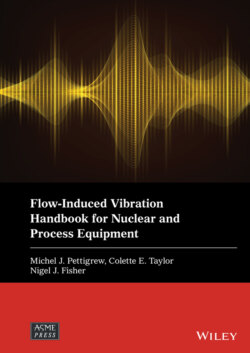Читать книгу Flow-Induced Vibration Handbook for Nuclear and Process Equipment - Группа авторов - Страница 43
2.4.4 Acoustic Resonance
ОглавлениеAcoustic resonance may take place in heat exchanger tube bundles when periodic‐wake‐shedding frequencies coincide with a natural frequency for acoustic standing waves within a heat exchanger cavity. The flow‐excited acoustic standing waves are generally transverse to both the axis of the tubes and to the direction of flow. Such resonances normally cause intense acoustic noise with sound pressure amplitudes that can exceed 160 dB. Tube, baffle and duct damage from fatigue may also occur, if nothing is done to eliminate the noise problem. Acoustic resonance is possible in gas heat exchangers with both finned and bare tubes.
Acoustic resonance requires two conditions: 1) coincidence of shedding and acoustic frequencies, and 2) sufficient acoustic energy to overcome the acoustic damping in order that sustained acoustic standing-wave resonance occurs.
An approach to acoustic resonance is given below. For more detail, refer to Chapter 11.
Frequency Estimates: As discussed earlier, periodic wake shedding is governed by the Strouhal number:
(2‐37)
The Strouhal number may be obtained from Eq. (2‐36) or from Fig. 2-16 for different tube bundle configurations and P/D ratios. The range of Strouhal numbers over which acoustic resonance can take place should be extended to allow for possible “lock‐in” of the wake. As suggested by Blevins and Bressler (1987), acoustic resonance may be possible between 0.8S and 1.3S, or in terms of periodic-wake-shedding frequency
(2‐38)
Acoustic standing wave frequencies, fan, are defined by:
(2‐39)
where W is the dimension of the heat exchanger tube bundle cavity in the direction normal to the flow and the tube axes, n is the mode order and Ce is the effective speed of sound (Ziada et al, 1989):
(2‐40)
The speed of sound, C, is obtained from
(2‐41)
where k is the specific heat ratio (k = 1.33 for steam), p is the shell side pressure and ρ is the shell-side fluid density.
The speed of sound is affected by the presence of the tubes. This effect is related to the solidity ratio, σ, which is the ratio of the volume occupied by the tubes over the volume of the tube bundle. For a triangular tube bundle
(2‐42a)
and, for a square tube bundle
(2‐42b)
The acoustic standing wave frequencies should be calculated for the first few acoustic modes (i.e., the first five modes should suffice). If one or more acoustic mode frequencies fall within the range of periodic‐wake‐shedding frequency, acoustic resonance conditions are possible.
